第3章
MOROK.
The month of October, 1831, draws to its close.
Though it is still day, a brass lamp, with four burners, illumines the cracked walls of a large loft, whose solitary window is closed against outer light.A ladder, with its top rungs coming up through an open trap leads to it.
Here and there at random on the floor lie iron chains, spiked collars, saw-toothed snaffles, muzzles bristling with nails, and long iron rods set in wooden handles.In one corner stands a portable furnace, such as tinkers use to melt their spelter; charcoal and dry chips fill it, so that a spark would suffice to kindle this furnace in a minute.
Not far from this collection of ugly instruments, putting one in mind of a torturer's kit of tools, there are some articles of defence and offence of a bygone age.A coat of mail, with links so flexible, close, and light, that it resembles steel tissue, hangs from a box beside iron cuishes and arm-pieces, in good condition, even to being properly fitted with straps.A mace, and two long three-cornered-headed pikes, with ash handles, strong, and light at the same time; spotted with lately-shed blood, complete the armory, modernized somewhat by the presence of two Tyrolese rifles, loaded and primed.
Along with this arsenal of murderous weapons and out-of-date instruments, is strangely mingled a collection of very different objects, being small glass-lidded boxes, full of rosaries, chaplets, medals, AGNUS DEI, holy-
water bottles, framed pictures of saints, etc., not to forget a goodly number of those chapbooks, struck off in Friburg on coarse bluish paper, in which you can hear about miracles of our own time, or "Jesus Christ's Letter to a true believer," containing awful predictions, as for the years 1831 and '32, about impious revolutionary France.
One of those canvas daubs, with which strolling showmen adorn their booths, hangs from a rafter, no doubt to prevent its being spoilt by too long rolling up.It bore the following legend:
"THE DOWNRIGHT TRUE AND MOST MEMORABLE CONVERSION OF IGNATIUS MOROK, KNOWN AS THE PROPHET, HAPPENING IN FRIBURG, 1828TH YEAR OF GRACE."
This picture, of a size larger than natural, of gaudy color, and in bad taste, is divided into three parts, each presenting an important phase in the life of the convert, surnamed "The Prophet." In the first, behold a long-bearded man, the hair almost white, with uncouth face, and clad in reindeer skin, like the Siberian savage.His black foreskin cap is topped with a raven's head; his features express terror.Bent forward in his sledge, which half-a-dozen huge tawny dogs draw over the snow, he is fleeing from the pursuit of a pack of foxes, wolves, and big bears, whose gaping jaws, and formidable teeth, seem quite capable of devouring man, sledge, and dogs, a hundred times over.Beneath this section, reads:
"IN 1810, MOROK, THE IDOLATER, FLED FROM WILD BEASTS."
In the second picture, Morok, decently clad in a catechumen's white gown kneels, with clasped hands, to a man who wears a white neckcloth, and flowing black robe.In a corner, a tall angel, of repulsive aspect, holds a trumpet in one hand, and flourishes a flaming sword with the other, while the words which follow flow out of his mouth, in red letters on a black ground:
"MOROK, THE IDOLATER, FLED FROM WILD BEASTS; BUT WILD BEASTS WILL FLEE
FROM IGNATIUS MOROK, CONVERTED AND BAPTIZED IN FRIBURG."
Thus, in the last compartment, the new convert proudly, boastfully, and triumphantly parades himself in a flowing robe of blue; head up, left arm akimbo, right hand outstretched, he seems to scare the wits out of a multitude of lions, tigers, hyenas, and bears, who, with sheathed claws, and masked teeth, crouch at his feet, awestricken, and submissive.
Under this, is the concluding moral:
"IGNATIUS MOROK BEING CONVERTED, WILD BEASTS CROUCH BEFORE HIM."
Not far from this canvas are several parcels of halfpenny books, likewise from the Friburg press, which relate by what an astounding miracle Morok, the Idolater, acquired a supernatural power almost divine, the moment he was converted--a power which the wildest animal could not resist, and which was testified to every day by the lion tamer's performances, "given less to display his courage than to show his praise unto the Lord."
Through the trap-door which opens into the loft, reek up puffs of a rank, sour, penetrating odor.From time to time are heard sonorous growls and deep breathings, followed by a dull sound, as of great bodies stretching themselves heavily along the floor.
A man is alone in this loft.It is Morok, the tamer of wild beasts, surnamed the Prophet.
He is forty years old, of middle height, with lank limbs, and an exceedingly spare frame; he is wrapped in a long, blood-red pelisse, lined with black fur; his complexion, fair by nature is bronzed by the wandering life he has led from childhood; his hair, of that dead yellow peculiar to certain races of the Polar countries, falls straight and stiff down his shoulders; and his thin, sharp, hooked nose, and prominent cheek-bones, surmount a long beard, bleached almost to whiteness.Peculiarly marking the physiognomy of this man is the wide-
open eye, with its tawny pupil ever encircled by a rim of white.This fixed, extraordinary look, exercises a real fascination over animals--
which, however, does not prevent the Prophet from also employing, to tame them, the terrible arsenal around him.
Seated at a table, he has just opened the false bottom of a box, filled with chaplets and other toys, for the use of the devout.Beneath this false bottom, secured by a secret lock, are several sealed envelopes, with no other address than a number, combined with a letter of the alphabet.The Prophet takes one of these packets, conceals it in the pocket of his pelisse, and, closing the secret fastening of the false bottom, replaces the box upon a shelf.